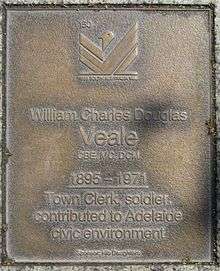W. C. D. Veale

Brigadier William Charles Douglas Veale, CBE, MC, DCM, ED, FAPI, FIMA (16 May 1895 – 17 August 1971),[1][2] was generally known, and referred to, as W. C. D. Veale. He is best known as the longtime (1947–1965) town clerk (CEO) of the Adelaide City Council[3] and had significant influence in the development and change of character of the City of Adelaide during that period. For example, in conjunction with four-time Lord Mayor of Adelaide Arthur Campbell Rymill, he was responsible for significant improvements to the Adelaide Park Lands. He was also known as a soldier and engineer in World War II at the Battle of Timor and during the Japanese occupation of the Dutch East Indies.
Veale Gardens in Adelaide's South Parklands is named in his honour.
Early years
Veale was born in Bendigo in 1895, and apprenticed to an engineer at the Whittlesea Council in Morang, Victoria.[2]
World War I
On 14 February 1916, Veale enlisted in the Australian Imperial Force.[2]
Beginning on 9 October 1917, he helped to lay "jumping off" tapes while under fire, and then moved wounded members of his party to safety. He was awarded the Distinguished Conduct Medal.[2]
He was promoted Lieutenant in May 1918. On the night of 28–29 August 1918, near Péronne, Somme, France, he supervised, at short notice and without alerting the enemy, the construction of two bridges needed by the infantry next morning. For this deed he was awarded the Military Cross.[2][4]
Inter-bellum
After a period working at Stoke-on-Trent and the Ministry of Transport in London, he returned to Victoria, serving as Engineer to the Shire of Kowree Council at Edenhope.[2]
On 12 February 1923 at All Saints' Church of England, Bright, he married Eileen Guest.[2]
He was appointed Assistant City Engineer & Surveyor to the City of Adelaide on 8 October 1923 at an annual salary of A£450. In 1926 he became Deputy City Engineer, City Engineer in 1929 and Town Clerk in 1947, serving with the Militia rising to Colonel.[2]
World War II
- 1936-07-01 – 1936-09-30 Commanding Officer 10/50th Infantry Battalion
- 1936-10-01 – 1940-04-02 Commanding Officer 10th Infantry Battalion
- 1940-07-01 – 1941-09-25 Commanding Officer 2/3rd Pioneer Infantry Battalion[7]
- 1941-09-26 – 1941-09-30 Commander Royal Engineers 7th Military District
- 1941-10-01 – 1942-02-11 Chief Engineer 7th Military District
- 1942-02-13 – 1942-06-30 Commanding Officer Sparrow Force (Battle of Timor)
- 1942-07-01 Commandant of Engineer Training Centre New South Wales
- 1944-03-14 – 1944-06-07 Commanding Officer Moresby Base Sub-Area
- 1944-06-08 – 1945-XX-XX Chief Engineer 2nd Australian Army
- 1945-05-18 Chief Engineer 1st Australian Army
- 1946-04-25 Reserve of Officers honourary brigadier
Post-war
In January 1947 Veale was appointed town clerk.[2]
Retirement
Veale retired in November 1965.[2]
He died on 17 August 1971 in North Adelaide and was cremated; his wife and their two daughters survived him.[2]
Honours and awards
- Commander of the Order of the British Empire (CBE) - 1954
- Military Cross (MC) - 1919[8]
- Distinguished Conduct Medal (DCM) - 1918[9]
- Efficiency Decoration (ED)
- FAPI - he was federal president (1954-55) of the Royal Australian Planning Institute[2]
- FIMA - Fellow of the Institute of Municipal Administration[2]
See also
References
- ↑ Biographical cuttings on William Charles Douglas Veale, nla.gov.au
- 1 2 3 4 5 6 7 8 9 10 11 12 13 Robert Thornton (2002). "Veale, William Charles (1895–1971)". Australian Dictionary of Biography. MUP.
- ↑ Veale Gardens, Rose Garden Walking Trail, Adelaide City Council
- ↑ The London Gazette: (Supplement) no. 31158. p. 1738. 1 February 1919. Retrieved 5 January 2015.
- ↑ Brig Veale, www.generals.dk
- ↑ V84544 William Charles Douglas Veale, MC, DCM, www.awm.gov.au
- ↑ 2/3rd Pioneer Battalion, www.awm.gov.au
- ↑ Military Cross, 1919
- ↑ Distinguished Conduct Medal, 1918
External links
- Brig Veale, circa 1945, www.generals.dk